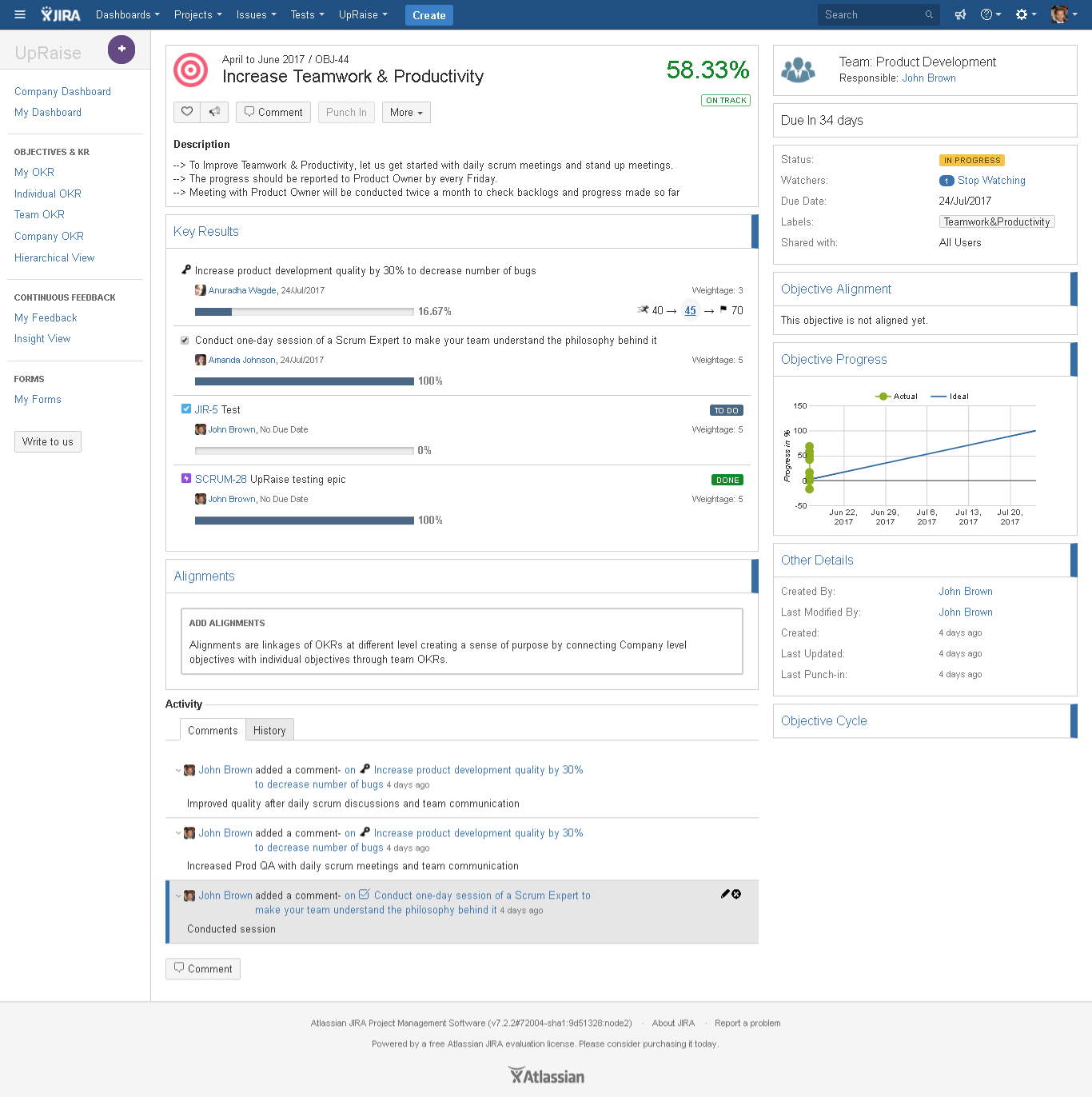When to use each type of KR - To do, Metric, Jira Issue? (before v3.8.3)
Key results vary from employee to employee across all the departments but in the end, they are designed to collectively achieve their respective team’s goals & consequently company goals. Within Employee Success, you will find three types of Key results.
Metric
To to
Jira issue
Each level of the objectives (company, team, individual) can have the same types of key results.
Each key result is different from others and has a different purpose too. Let us see examples of these key results within Employee Success.

This is an example of team level objective in Employee Success. On the next image, we have added a metric type key result to this objective.
Metric
These metric type key results should be measurable and at the same time, it should be ambitious. Key results are meant to be a bit difficult but not impossible. When we say measurable, it means you should have some numbers associated with a metric KR so you can measure it against the objective. Eg. increase profit by 30% or increase sales revenue by 20%.
When we say metric should be difficult then it means you should set some high-level deadlines those are difficult to achieve but not completely impossible. e.g. If You have a metric called grow sales turnover by 75% and you achieve 100% increment in sales turnover then it means your metric wasn't ambitious and difficult enough.

In the example mentioned in the image above, You can see this key result has a measurable aim to achieve. You know where you stand currently and what are you aiming for.
To do
To do type of KRs are binary in nature. They are either incomplete or complete. These KRs are sort of important to do's those are going to help you in achieving a main goal/objective. Eg. Conduct one-day session of a scrum expert to make your team understand the philosophy behind it. This to do will be either complete or incomplete.
In the image below, the checkbox is unchecked and progress is 0%.

In this image, the checkbox in checked and progress is 100%.

Jira issue
Important
Important to know that there are two schools of thought with regards to whether Jira issues make for a good key result. While we think in some select cases it makes sense to use Jira issues as KRs, some OKR coaches think it is outright wrong. You will need to make your own decision about it.
Employee Success supports both these variations. Either you can add Jira issues as Key Results or can connect them as Actions to key results. That is dependent on your configuration explained here.
This helps you to keep track of Jira issue progress within Employee Success by connecting Jira issues with your Objectives. Employee Success integration with Jira comes in the picture here. When you want to add Jira epics or Issues as KR to an objective, use Jira issue type KR here. For example, you can a connect an epic or Jira Issue that exists in your Jira and it's related to your objective as well.

In the image above, you can notice JIR-5 test is a Jira issue, SCRUM-28 is an epic. When you open an issue or an epic within Jira and mark its progress there itself, it gets reflected within Employee Success with its progress as well as status.
You might have noticed every KR type has some weightage associated with it. You can check details related to weightage on this page.
At the end, your entire objective detail page will look like this with all KRs and the progress made by your Team on the objective.

On this page
In this section
- How to add KR punch-in reminders?
- How does automatic confidence score calculation work?
- What are different OKR confidence statuses(default) in UpRaise?
- Default confidence status calculations
- How to use KR progress automation?
- How to move Key results?
- Use cases for Browse OKR filters
- Create, edit or delete objectives
- How to browse through your OKRs from browse OKRs page?
- Concepts - Objectives, Key Results, Punch-ins, Alignment, Weightage, Grading, Labels
- How do I add & delete objective alignments?
- How do I adjust weightage of a KR?
- How do I create, edit & delete key results?
- How do I grade my OKRs?
- How do I mark progress on objectives or key results?
- How does progress roll up work in alignment?
- How does the progress calculation of Jira issues and epics works?
- How does weightage of a KR impact the objective progress?
- How to add Jira issue KR via JQL?
- How to add Jira issues as actions in metrics and to do KRs?
- How to carry forward an objective?
- How to clone an objective?
- How to convert objective from one level to another?
- How to move an objective?
- How to use objective details page?
- Is alignment possible only for objectives?
- What are different objective statuses?
- What is hierarchy view & how does it work?
- What is KR detail page?
- What is objective cycle?
- What is the impact of objective visibility on alignment?
- What type of KRs are possible in Employee Success?
- What type of objective visibility options are available?
- When to use each type of KR - To do, Metric, Jira issue & Jira issue via JQL?
- Why I can't create / edit company level, team level or individual level objectives?
- Why isn't the punch-in action available on my objective?